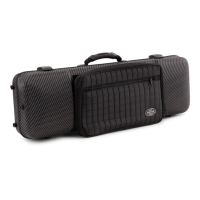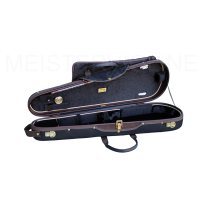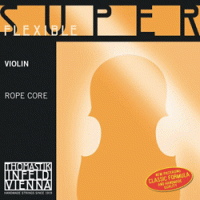Guide to choosing a caseA prerequisite for the pain-free storage and safe transport of string instruments is in any case a good case. In this matter it is not worth saving money, because a good case provides indispensable services for both the violin and the viola or cello. The following "touchstones" should be considered: 1. the quality of manufacture The wide range of prices on the market is very impressive. One comes across various violin cases that look identical and even advertise the same features. One costs 79,00 EUR, the other 799,00 EUR. Of course, the former will be a cheap industrial copy from the East, the latter will be handmade by a master craftsman. It should be noted that the violin, for example, floats inside the case due to the special upholstery work and is held firmly at the same time. It is also important to check that the materials are durable and have been expertly crafted. 2. portability Handle devices, backpack straps or side straps- they can all be found on the market in a wide variety of qualities. Appreciated are the metal fasteners anchored to the wooden core. However, it must be said that the fastenings sewn to the cover, as found in cases made by master craftsmen, last better and longer than other products of an industrial nature. Think not only of the fastenings of the straps, but also of all the sewing work on the cover and other internal textile parts of the case. 3. control of climatic conditions in the case Many violins are silent bearers of their "winter cracks". It is the air dryness and sudden climatic changes that cause cracks on the instrument. However, this can be prevented and ultimately avoided by making use of the already common technical devices. These are: the hygrometer, the humidifier and the thermometer. The most common types of cases The shaped case The shaped case is the most known and common way to carry the violin or viola for centuries. Even in the minds of non-musicians, this case has become the epitome of the violin case due to the gangster movies of the 1930s from Chicago. If we take a closer look at the requirements that musicians in previous centuries had for their violin cases, we notice that they were far below the requirements that musicians have today. Possibly this is due to the considerably greater age of the instruments and the idea of preservation, to which an ever greater value is attributed. However, it is indisputable that a violin or a violin bow that is carefully stored in its shaped case or violin case will survive undamaged for centuries in most cases, which arouses not a little amazement! Due to the special shape of the form case, which fits the contours of the violin, this case is the most space-saving way to store a violin or viola. It was realized early on that weight can be reduced to a minimum in this way, which is probably the reason for the widespread use of the formetui. Although additional storage space is spared, there is still room for the violin or viola bow in the shaped case. Furthermore, there is a small compartment for accessories such as rosin or strings. Some shaped cases have an attached music pocket for transporting sheet music. The case for violin or viola The violin case as a carrying case represents a different carrying concept than the shaped case. Here the focus is not on saving space, but on the practical needs of the musician. This means that sheet music and other accessories for the violin can be carried without any problems. Whereas with the shaped case the sheet music has to be carried in an additional pocket, the violin case has a sewn-on sheet music pocket with plenty of space for sheet music. Usually this is covered with a rainproof cover, mostly made of rainproof polyester. Such a case also has space for four bows, shoulder rest, rosin, mute, spare parts and other accessories. The violin case usually weighs about 3kg, the viola case about 3.5kg. There are special flat models that are particularly suitable for flying. Most violin or viola cases have a hygrometer and a humidifier. It is highly recommended to keep these devices under constant observation, because the air dryness of the environment can cause cracks on the stringed instrument. A string tube for storing strings is practical. Standard for the violin case are additionally the backpack straps, which allows carrying the violin on the back. Also practical is the subway handle, with which the violin can be carried comfortably in a vertical position, as is the case when standing on the bus or subway, for example. The double case for violin or viola How often has the musician wondered under the trouble of transporting two instruments, "Why do I have to handle two cases in my hand now!..." Having to carry a violin plus a viola is not uncommon in professional practice or in a music business. The question then arises of how to transport the violin and viola together safely and practically. In this case, the double case has become an essentially indispensable working tool. It allows safe and effortless transportation of the instruments with the avoidance of accidents and annoying lugging. If a double case for violin and viola is needed, special attention must be paid to whether the viola fits inside without any problems. It is the viola where the greatest variation in dimensions can be found. For the viola, the body length often varies between 38cm and 43cm, an ultimately wide range. Some double cases have an adjustable interior for the different body lengths. As a rule, the double cases have enough space to store sheet music and bows. You can find cases in a wide variety of price ranges. From the Luiteria double violin case to the noble Original Jaeger double case with its classic flat design. If necessary, one can have a double case custom made according to one's own needs. Nowadays, among other things, cases are produced with the modern material carbon. This material is used to make extremely light and safe cases. With 2.6kg case weight, a violin is very comfortable and easy to carry. The cello case The cello case provides the most massive and safe protection for the cello. Made of quite durable materials such as fiberglass or carbon fiber reinforced resin, these cases offer maximum transport safety. A cello case can also be equipped with built-in heavy-duty wheels. This greatly facilitates mobility and the cello does not have to be carried exclusively. The transport is thus relaxed. The cello case usually has an accessory pocket for rosin and strings and has sufficient space for the cello bow. Thanks to high-tech technology, nowadays there are very light cello cases made of carbon, reducing the weight to up to 2.9kg. Nevertheless, they have a high resistance and stability. The cello case A big advantage of the cello case is certainly the light weight. Nowadays, cello cases are very well equipped with up to 25mm of padding. A cello sleeve with wheels is very advantageous. There is also plenty of space on the case for sheet music and cello bows. Usually a cello case has several grip devices around the case, which makes carrying it very easy. |
Copyright © 2006-2024 Meistervioline.com - Online store for string instruments & accessories Trusted Shops certified since 2017Shopsystem: Zen Cart




